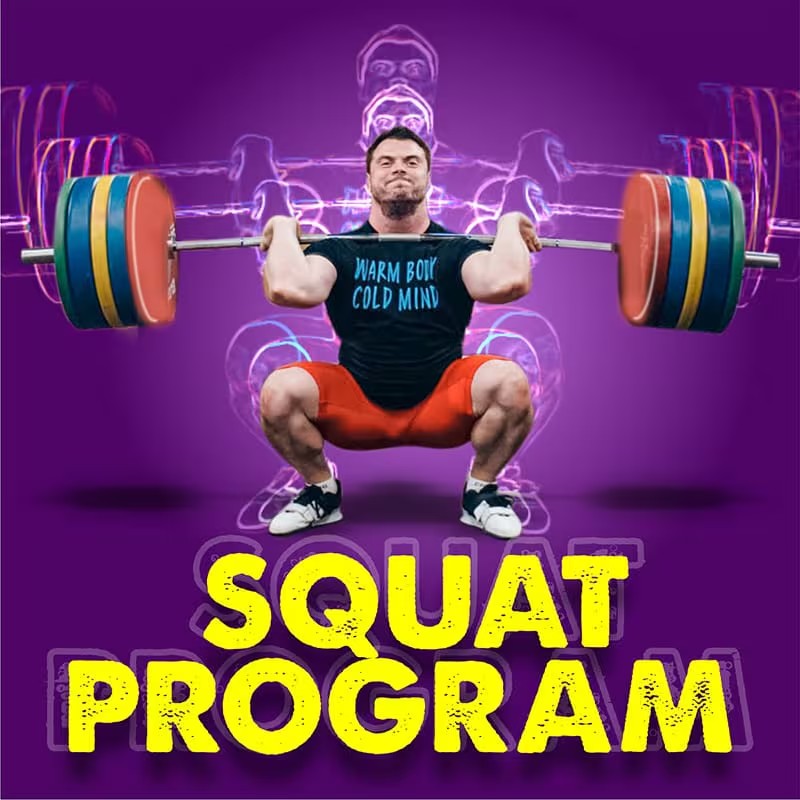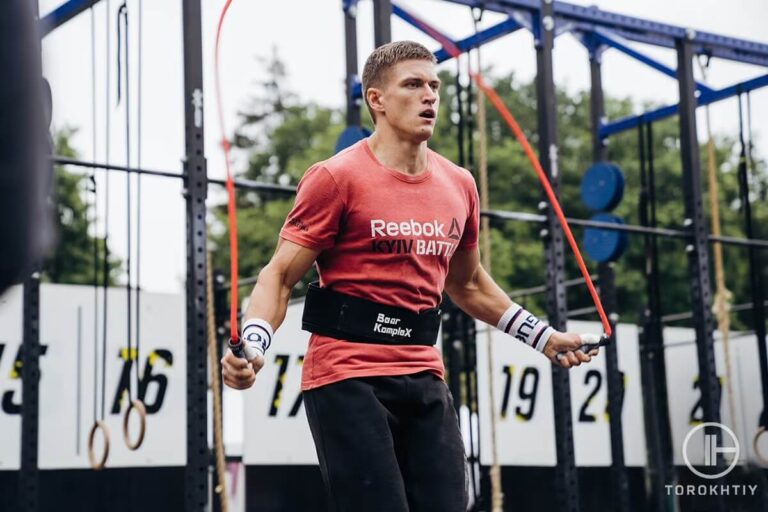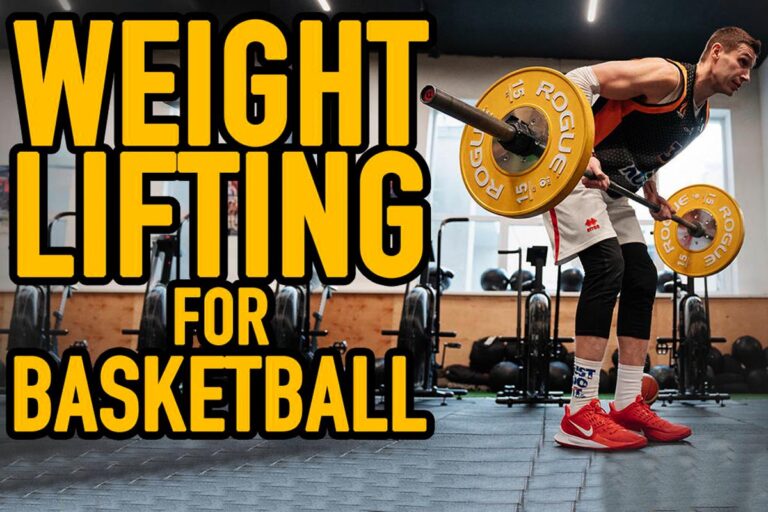Front Squat Grip Secrets – Techniques & Tips
Squats are one of the most common exercises that a lifter can do. And while the back squat is the most popular one, the front squat can give the back squat a run for its money (depending on what the lifter wants to achieve).
In order to perform a front squat (with the barbell), you’ll have to think of how you’ll be holding the barbell. This is the gist of today’s article – the front squat grip.
Besides just focusing on the squatting movement, you need to start off with the basics – holding the barbell correctly. There are a number of front squat grip variations that are being used, and we’ll deep-dive into all of them; name them, explain them and teach you how to perform them correctly.
Let’s grip that squat!
What is the front squat grip? This refers to the way you’re holding the barbell while performing a front squat. The three most common front squat grips are clean grip, cross-arm grip, and strap grip. There are also variations. Each grip has its own advantages.
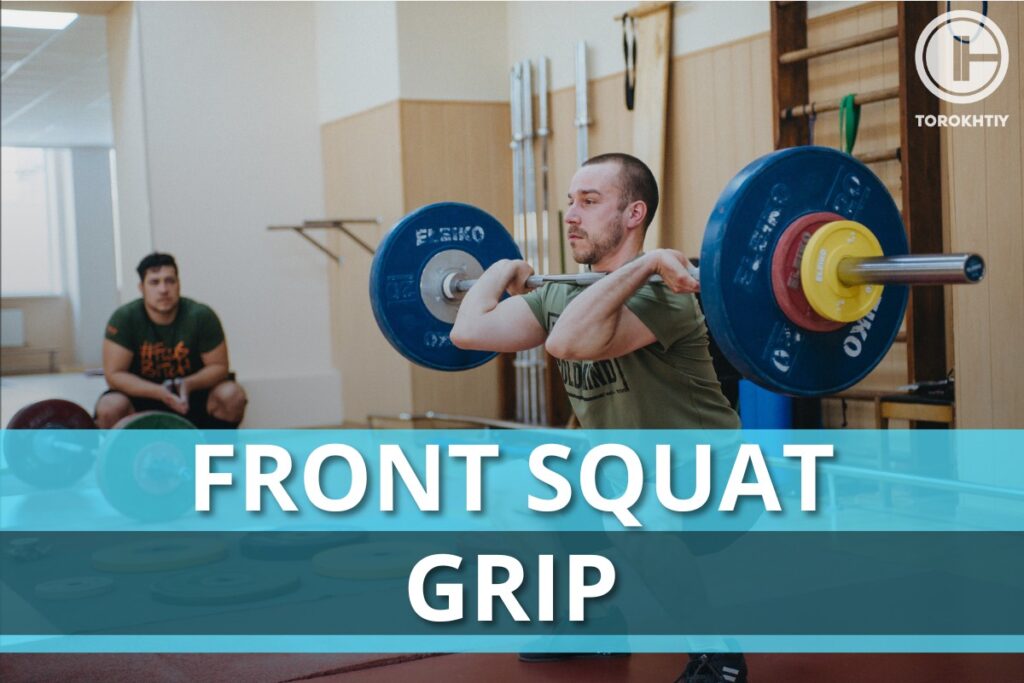
What Are Front Squat Grips?
Squats are amazing – they engage a lot of muscle groups at the same time, they’re used in rehabilitation, and they can work wonders for your lower body. That is, if you know how to do them correctly because if your form is off or you don’t get the right depth, you won’t engage the muscles you’re trying to target enough to see results.
There’s a whole bunch of stuff that goes into doing the perfect squat, but we’ll focus on the front squat hand position (the way you hold the barbell while you’re squatting).
Your grip is a huge part of squatting because it affects how your body moves and which muscles are engaged. And if your grip fails, you’re in a world of trouble and you can actually end up injured.
There’s a few main types of the front squat grip, but one of the most common ones is the crossed-arm grip, where you cross your arms in front of your chest and keep your palms up.
There are some benefits to it, like the fact that it helps you keep your torso upright, which also means that it helps you keep your form correct. Your form is key to getting the most out of any exercise (and preventing injuries), and that includes squats.
If you want to master front squats, you’ll need to get the hang of the proper front squat arm position. Be prepared to try a few different ones out because people have different levels of flexibility and comfort, so it’s best to try a few different kinds to see which one works for you.
3 Main Types of Front Squat Grips
If you’re wondering what’s the best way to hold the bar – we don’t have an exact answer for you, sorry. There are a few different ways you can grip it, but as far as the best front squat hand placement goes, that comes down to what you like and what feels the most comfortable.
Let’s see what are the three main types of front squat grips.
| TYPE OF GRIP | DESCRIPTION |
|---|---|
| Clean Grip | Hold the barbell with an overhand grip, with it resting on the front of the shoulders. Elbows are raised and create a shelf for the bar. |
| Crossed Arm Grip | Arms crossed in front of the chest with palms facing up and the bar resting on the anterior deltoids. Simple and effective, good for people who have issues with the flexibility of their wrists and shoulders. |
| Strap Grip | Uses lifting straps. Loop the straps around the bar and hands and hold the straps instead of the barbell directly. Allows for a more relaxed hand positioning and reduces the demand on wrist flexibility. |
1. Clean Grip
If you’re squatting, there’s little to no chance you don’t know what a clean grip is (also known as Olympic grip). Basically, you hold the barbell with an overhand grip and allow it to rest on the front of your shoulders.
The elbows are raised and they create a kind of a shelf for the bar to sit. If you want to give the clean grip a try, you’ll need a certain amount of shoulder and wrist mobility , so if that’s a problem for you, you might want to work on it first.
The benefit of that grip is that your upper back is definitely more stable because of shoulder rotation, you can use higher loads and it will allow you to do other kind of exercises like jerks, push presses, thrusters etc. more efficiently.
2. Crossed Arm Grip
This is another super common way to hold the bar, and it’s also called the “bodybuilder” grip. You cross your arms in front of the chest with your palms facing up so that the bar rests on the anterior deltoids.
The crossed arm grip is popular because it’s simple and effective, and it’s especially good for people who have issues with the mobility of their wrists because of the specific front squat hand position. The downside is that you can’t control the bar position in the same way you can with a clean grip.
3. Strap Grip
This one will need some lifting straps that you loop around the bar and hands and then you hold onto the straps instead of directly gripping the bar. If you feel like the strap grip is more hassle than it’s worth, you’re wrong because it allows your arms to be positioned in a more “relaxed” way, plus your wrists don’t need as much flexibility.
When you compare this to the clean grip, you’ll notice that the latter needs your wrists/shoulders to be flexible enough to support the bar, which can be a problem for some people. If you’re one of them, the strap grip will be a much better option.
2 Front Squat Grip Variations and Their Benefits
Apart from the three most common (main) front squat grips, there are also variations.
1. Two Finger Grip (Semi Clean Grip/ Partial Clean Grip)
This one can be pretty challenging for a lot of people, but did you know it has a nifty variation? It’s called the two finger grip, or a partial clean grip, and it’s great because it takes away some of the strain your wrists need to handle, but still gives you the some benefits of a normal clean grip.
If you’re dead set on the clean grip but feel like it’s almost impossible to do, give this variation a try.
3. Zombie Grip
Now, if you thought the bodybuilder grip has the coolest name, you’re totally wrong because nothing beats the zombie squat, which is not exactly a grip (and, no, it’s not something that Zombies do), but it’s still worth mentioning. You don’t actually hold the bar during zombie squats.
Instead, you extend your arms straight out in front of your body, parallel to the floor, and focus on keeping your torso upright while balancing the bar. It’s tough to do, yes, but it promotes balance and engages your core. Excellent way to work on your front squat movement pattern and balance.
There are more variations, since we’re all built differently and different things might work for different people. However, these two (above) would be the most common ones used, next to the three big ones.
3 Common Mistakes and How to Avoid Them
You’ll make mistakes and there’s no way around that. But making a mistake here and there is part of the learning process, while repeating the same mistake over and over just means you’re wasting your time. There are a few mistakes almost everyone makes at least once, but the good news is, there are ways of fixing them.
1. Incorrect Weight Distribution
Correct form prevents injuries and every mistake you make comes from your form and technique being off. One such mistake is incorrect weight distribution, where the weight shifts forward onto your toes and makes you lose balance. Make sure to maintain a balanced weight distribution over the middle of your feet.
2. Neglecting Correct Elbow Position
Another common mistake is letting your elbows drop. Think like they should (from a side view) point out more or less to 3 o’clock – keeping your elbows up helps you keep your back straight, chest up, and makes the squat deeper and better. If your elbows fall, your form is off and you won’t work the right muscles as much.
🔻12 Week Squat Program by Oleksiy Torokhtiy
Do you want to double your squat strength? In just 12 weeks, you’ll be able to boost your squat results.
This program transforms any ordinary squat into a powerful athletic movement.
What’s included:
- 12 weeks of squat programming;
- Effective combination of sets, reps, and weights;
- Fully designed and coached by Oleksiy Torokhtiy;
- Over 60+ movements, banded work, and weight training;
- Accessory work for core, joint stability and injury prevention;
- Max out on back squat and front squat at the end.
Start now and boost your squat results!
3. Rounded Back
Rounded back is another really common issue and it can really strain your lower back and compromise your form. Your spine should be neutral during the entire squat to prevent strains and injuries, but also to get all the benefits squatting has. Keep your chest up, shoulders back, and you’ll get this down in no time.
How to Integrate Front Squat Grips into Your Routine?
It’s easier said than done, but if you want to include front squat grips in your routine, you’ll need to find a balance between comfort, effectiveness, and your fitness goals.
Start with simply experimenting with different grips and see which one works best with your body mechanics. The good thing is, each type of grip has its benefits, so it’s only a matter of time before you find the perfect one.
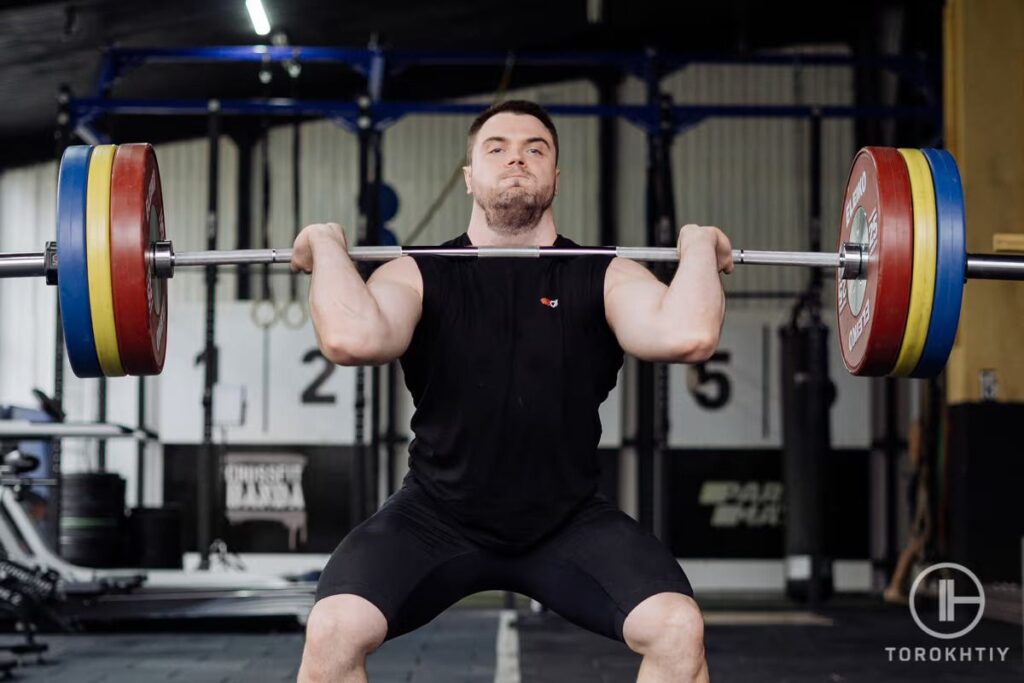
There are some other things to consider, like how flexible you are, and whether you have any issues with your wrists or not. If your wrists aren’t that flexible, a crossed arm grip will work better than the clean grip since the former is easier on the wrists.
If you’re recovering from injuries or if every other type of grip is too uncomfortable, the strap grip will probably be your bestie because it makes the exercise easier on your wrists. It’s all about trial and error; you can’t know what works if you don’t try it.
Don’t go crazy with the weight right at the beginning; use lighter weights and get familiar with the grip you chose before you up the load, and own the movement. Be consistent, make squats a regular part of your routine, and as you get better and more confident, it will be easier to lift heavier weights.
This entire thing is a process that won’t show results overnight. Arm yourself with patience and take your time to learn the proper form.
FAQ
How do you hold hands when doing front squats?
This depends on the grip you’re using (clean, cross-arm, strap grip, or a variation). Each different grip might affect how you’re holding your arms while performing the front squat movement.
Why can’t I grip the front squat?
If you’re having any troubles while performing any of the front squat grips, it might be that you’re lacking mobility in your shoulders (internal rotation), or that you’re simply positioning yourself incorrectly. In that case, it is best to consult a trainer, or an experienced lifter to correct/assist you in perfecting your gripping technique.
What is the best stance for front squats?
You want to place your feet at shoulder width. A little bit wider is ok, but don’t overdo it. Point your toes forward or out a tad bit to allow for natural knee movement. The main point is that you are balanced and that you feel comfortable. Everyone is built differently and adjustments might be required.
Conclusion
To the average Joe or a complete beginner, all squats performed with a barbell look the same. If you’ve even noticed something, it’s likely the weight plates.
Once you get a bit more seasoned, you start noticing the grip, the fingers and the way your arms are positioned while doing the squat exercise. So, it is not uncommon to be surprised by all the different ways that a lifter can hold a barbell in order to achieve the perfect squat.
Well – now you know! The next time someone asks you how to hold the bar for a front squat, you’ll be able to tell them. We went through the main grip types, as well as a couple of variations.
Some of them even have really cool names (there’s no way you’ll forget the zombie squat). Also, you’ll know when to use each type of grip, and how each affects your body.
What we want now is to hear from you! Which of these front squat grips is your favorite? Why? What did you struggle with the most before you got the proper front squat grip? And most importantly – do you have anything to add?
Tips, tricks, experiences, and even questions! Leave them all in the comments section below. We’d be delighted to hear them. 🙂
Gripping out!
References:
- Health Promotion Board (HPB) “Prevent Injuries with Proper Form During Workouts,” Singapore University Health Center, https://www.nus.edu.sg/uhc/articles/details/prevent-injuries-with-proper-form-during-workouts (accessed February 26th, 2024)
- Keitaro Kubo, Toshihiro Ikebukuro, Hideaki Yata, “Effects of squat training with different depths on lower limb muscle volumes,” European Journal of Applied Physiology 119, no. 9 (2019): 1933-1942.
- Lindsay V. Slater, Joseph M Hart “Muscle Activation Patterns During Different Squat Techniques,” J Strength Cond Res 31, no. 3 (2017): 667-676.
- Luke Del Vecchio “The Health and Performance Benefits of the Squat, Deadlift, and Bench Press,” MOJ Yoga & Physical Therapy (April 2018).
- Tim Bishop “Stronger Legs and Lower Body,” Human Kinetics, https://us.humankinetics.com/blogs/excerpt/proper-form-and-technique (accessed February 26th, 2024)
- All photos are made by our Torokhtiy Media Team
Why Trust Us?
With over 20 years in Olympic Weightlifting, our team does its best to provide the audience with ultimate support and meet the needs and requirements of advanced athletes and professional lifters, as well as people who strive to open new opportunities and develop their physical capabilities with us.
By trusting the recommendations of our certified experts in coaching, nutrition, dietology, and sports training programming, as well as scientific consultants, and physiotherapists, we provide you with thorough, well-considered, and scientifically proven content. All the information given in the articles concerning workout programming, separate exercises, and athletic performance, in general, is based on verified data. We ensure that you can rely on our professionals’ pieces of advice and recommendations that can be treated as personalized ones which will benefit you and fully meet your needs.
The product testing process is described in more detail here
Author: Jacek Szymanowski
Certified Nutritionist,
M.Sc.Eng. Biotechnology
Performance Architect,
Strength and Conditioning Specialist
With over 30 years of fighting experience, specialization in nutrition coaching for athletes, and expertise in metabolic health and dietary strategies, Jacek offers a comprehensive approach to optimizing your performance and well-being. Backed by a Master of Science degree in Biotechnology, Jacek remains at the forefront of scientific advancements, ensuring that his coaching is always evidence-based and up-to-date.

